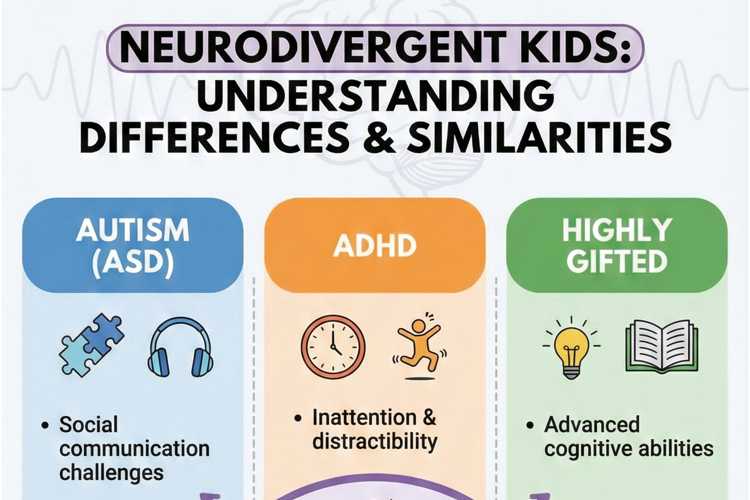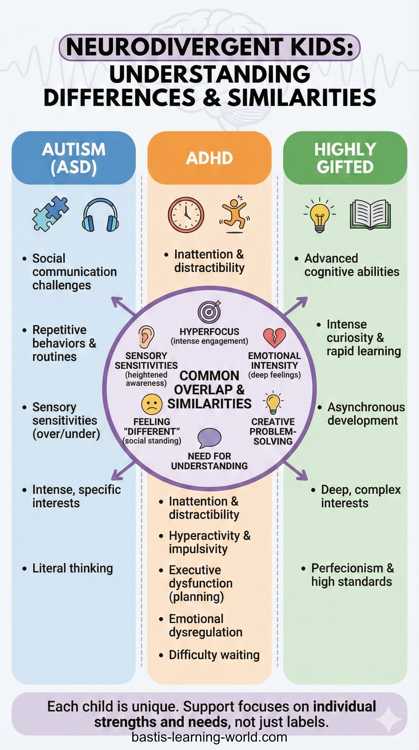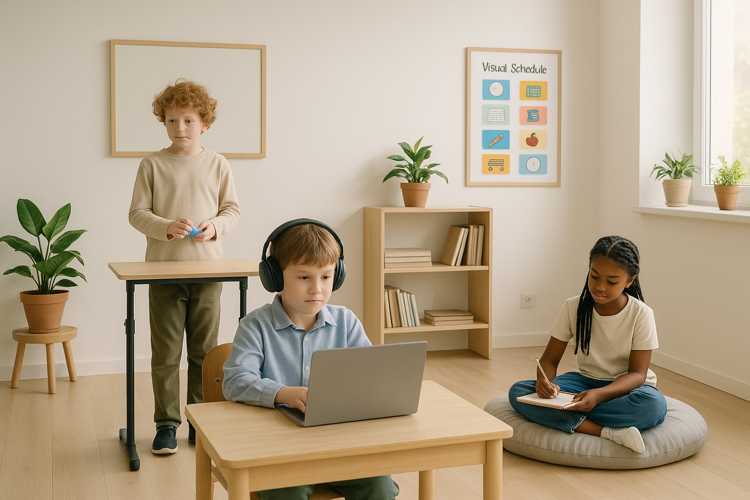Autism, ADHD, or Gifted? A Visual Guide to Differences and Overlaps

Image made with AI (DALL-E)
Struggling to tell the difference between sensory quirks, high energy, and advanced learning? Use this visual cheat sheet to identify the "2e" overlaps and understand what your child is really trying to tell you.
The "Wait, What?" Moment Every Parent Knows
Your 8-year-old just spent six hours building an elaborate Minecraft world while completely ignoring dinner, bedtime, and your existence. Tomorrow, they'll forget their backpack, lose three pencils, and ask you the same question seventeen times.
So... which is it? Gifted hyperfocus? ADHD? Autism? All three? None of the above?
Welcome to the most confusing guessing game in modern parenting. Spoiler alert: the answer is often "yes, and..." not "either/or." Today's visual guide will help you decode what your child's neurology is actually trying to tell you—without needing a PhD in developmental psychology or a color-coded spreadsheet (though we know you probably already have one).
Understanding the Neurodiversity Trifecta
Here's the thing nobody tells you at those parent-teacher conferences: autism, ADHD, and giftedness aren't mutually exclusive categories. They're more like a Venn diagram drawn by a toddler with three different markers—lots of overlap, some messiness, and occasionally all the colors end up in the same spot.
This overlap has a name: twice exceptional (2e), or when a child is simultaneously gifted AND neurodivergent. Some kids are even thrice exceptional—gifted with both autism and ADHD. Because why make things simple?
The challenge? These three conditions share enough surface-level similarities to confuse even experienced professionals. Intense interests, sensory sensitivities, social quirks, executive function challenges—they all show up across the spectrum. But the underlying causes and required supports differ dramatically.
Reality Check: High intelligence doesn't rule out autism or ADHD. Conversely, neurodivergence doesn't limit intellectual potential. Your child can be all the things simultaneously.
The Visual Trait Comparison: What You're Actually Seeing
Hyperfocus vs. Special Interests vs. Flow State
The ADHD Version: Your child can't start homework to save their life, but they'll play video games for eight hours straight. Hyperfocus kicks in with high-stimulation, high-reward activities. It's inconsistent, often screen-based, and disappears the moment something boring appears.
The Gifted Version: They dive deep into complex topics (ancient Egypt, quantum physics, endangered frogs) because mastery feels amazing. They'll shift interests when the challenge plateaus or a more intriguing topic emerges. This is flow state—externally motivated by the joy of learning.
The Autistic Version: Special interests serve a regulatory function. Your child might memorize every dinosaur species not just because it's interesting, but because the predictable information provides comfort. The interest persists across contexts, gets referenced in unrelated conversations, and doesn't necessarily serve a practical purpose.
The 2e Reality: Often it's all three mechanisms operating simultaneously. The gifted aspect drives the depth, autism provides the regulatory comfort, and ADHD determines whether they can disengage when necessary.
Sensory Sensitivities: Three Different Flavors
ADHD Sensory Profile: Regulation issues. Your child seeks intense sensory input (crashes into furniture, chews everything) OR gets overwhelmed quickly during transitions and high-stress moments. Sensory challenges spike with emotional dysregulation.
Gifted Sensory Profile: Heightened perception. They notice sounds, textures, and details others genuinely miss—"Mom, do you hear that buzzing?" Yes, sweetie, it's the refrigerator three rooms away. This sensitivity isn't necessarily distressing, just... very aware.
Autistic Sensory Profile: Processing differences with distress patterns. Specific textures, sounds, or lights cause genuine discomfort or pain. Your child develops avoidance strategies (covers ears, refuses certain clothing) that persist even in low-stress environments.
Pro Tip: Ask your child about their internal experience. "Does this sound bother you or did you just notice it?" The answer reveals whether you're dealing with sensitivity (awareness), sensory processing disorder (distress), or regulation challenges (context-dependent).
The Restlessness Riddle
Context is everything here:
ADHD: Fidgeting, distraction, and restlessness appear across ALL settings—even during preferred activities. Executive dysfunction (starting tasks, organizing materials, following multi-step directions) creates consistent challenges regardless of interest level.
Giftedness + Boredom: Restlessness appears specifically during under-stimulating tasks. Your child zones out during grade-level math but focuses intensely on advanced content. The "ADHD symptoms" vanish when appropriately challenged.
Autism: Stimming behaviors (rocking, hand-flapping, fidgeting) serve self-soothing functions rather than attention regulation. These increase during sensory overload or anxiety but aren't necessarily tied to task engagement.
How to Actually Figure This Out: A Step-by-Step Identification Process
Step 1: Become a Detective (The Fun Kind)
Grab a notebook and track specific behaviors for 2-4 weeks. Don't just write "distracted"—note the time, context, what happened right before, and how your child responded.
Use the ABC method:
- Antecedent: What happened right before?
- Behavior: What specifically did you observe?
- Consequence: What happened after?
This reveals patterns invisible to memory alone.
Step 2: The Multi-Method Assessment Approach
Single assessments miss 2e kids consistently. Here's what comprehensive evaluation includes:
- Cognitive/achievement testing to establish baseline abilities
- Behavioral rating scales from multiple observers (home, school, extracurriculars)
- Occupational therapy evaluation for sensory processing
- Detailed developmental history (early speech, motor skills, social play patterns)
- Executive function screening (organization, planning, task initiation)
Step 3: Look for the Scatter Pattern
2e profiles show significant variation across sub-tests. Your child might score 99th percentile in verbal reasoning but 15th percentile in processing speed. High composite IQ scores mask these discrepancies.
Demand sub-test analysis. This scatter pattern is often the 2e smoking gun.
Step 4: Trial Accommodations Before Labels Solidify
Implement supports and document what changes:
- For suspected ADHD: Try movement breaks, fidget tools, timers, and visual schedules
- For suspected giftedness: Provide above-grade-level material and interest-based projects
- For suspected autism: Reduce sensory load, provide advance notice of transitions, allow processing time
Which interventions create meaningful improvement? That information guides diagnosis and support planning.
Step 5: Ask the Right Questions
Interview your child about their internal experience:
- "When you can't sit still, what does your body feel like?"
- "Do these sounds hurt or just annoy you?"
- "When you're thinking about [special interest], what does that feel like?"
- "What helps you calm down when you're upset?"
Their subjective experience often clarifies what external observation misses.
Frequently Asked Questions
Can a child actually be gifted AND autistic AND ADHD at the same time?
Absolutely. Neurodiversity operates on multiple dimensions, not exclusive categories. Recent research confirms autism and ADHD frequently co-occur (30-50% overlap), and both can coexist with giftedness. Your child isn't broken—they're complex. Which, honestly, makes parenting way more interesting (and exhausting).
How do I tell if my child has ADHD or if they're just bored because they're gifted?
Context is your friend here. ADHD symptoms appear across ALL domains—even fun activities show executive dysfunction (starting, organizing, completing tasks). Gifted boredom is specific to under-challenging content and vanishes with appropriate stimulation. But here's the twist: many 2e kids have BOTH. Giftedness masks ADHD in elementary school because high IQ compensates for executive dysfunction. Diagnosis often emerges in middle school when organizational demands exceed compensation strategies.
What's the danger of getting this wrong?
Misidentification leads to mismatched supports. A gifted child diagnosed only with ADHD might receive medication without enrichment—treating symptoms while missing the underlying need. An autistic gifted child might get academic acceleration without sensory supports, increasing overwhelm and behavioral challenges. Wrong supports don't just fail to help—they often make things worse.
Why do sensory sensitivities show up in all three conditions?
Different mechanisms, similar appearances. Gifted individuals often have heightened sensory perception (they notice more). ADHD involves sensory regulation challenges (difficulty modulating responses). Autism involves sensory processing differences (the brain interprets sensory input differently, causing distress). An occupational therapist can assess which mechanism is operating.
My gifted child was just diagnosed with ADHD at age 12—how did we miss this?
You didn't miss it—it was masked. High IQ creates powerful compensation strategies that work in structured elementary environments. When task complexity increases (multiple teachers, long-term projects, abstract thinking), those compensations fail. This late diagnosis pattern is extremely common in 2e populations. Better late than never, friend.
The Bottom Line: What Your Child Actually Needs
Here's the truth nobody wants to admit: the label matters less than the supports.
Instead of obsessing over which category fits, ask: "What does this child's unique neurology require to thrive?"
Maybe it's:
- ADHD medication + advanced curriculum
- Sensory accommodations + gifted enrichment
- Social skills support + interest-based learning
- All of the above on Tuesdays and something completely different on Thursdays
Your child isn't a checklist to be completed or a diagnosis to be solved. They're a beautifully complicated human whose brain works differently—and that's not a bug, it's a feature.
Your Next Move: Schedule that comprehensive evaluation you've been putting off. Request sub-test analysis. Interview your child about their internal experience. Trial accommodations before committing to labels. And remember—you don't need perfect clarity to provide excellent support.
The visual guide above isn't about achieving diagnostic certainty from your living room. It's about developing the sophisticated understanding necessary to advocate effectively for your unique, complex, occasionally maddening, and absolutely extraordinary kid.
Now go forth and decode with confidence. And maybe stock up on pencils—you're going to need them regardless of which category applies.
Full Infographic

Disclaimer
This article is for general information purposes only and does not constitute medical, psychological, or therapeutic advice. For individual questions or health concerns, qualified professionals should be consulted.
Links marked with an asterisk (*) are affiliate links to external offers. If you click on such a link and make a purchase through it, we receive a commission from the provider. The price does not change for you.
Related Articles

The Science Behind Short Attention Spans and How to Work With Them
Discover the neuroscience of attention in ADHD and autism, plus practical classr...
9 min readProgress Tracking That Actually Helps Neurodivergent Learners Grow
Discover flexible, personalized progress tracking methods that work with neurodi...
10 min read
From Frustration to Fun - Turning Writing Practice Into Play
Discover game-based writing exercises that transform reluctant writers into eage...
9 min read
Building Reading Confidence Through Multisensory Activities That Actually Work
Discover research-backed hands-on reading techniques using touch, sound, and mov...
10 min read